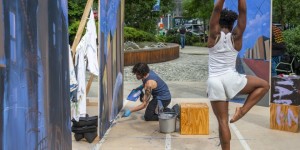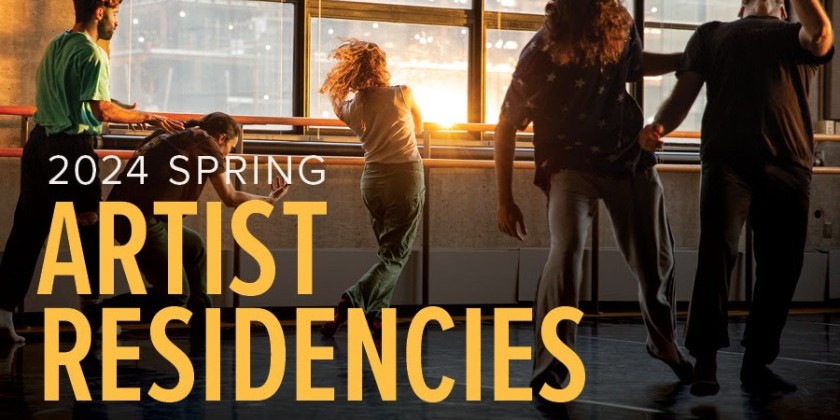IMPRESSIONS: Stefanie Batten Bland's "Kolonial" with Installation by Conrad Quesen, a World Premiere Commissioned by Baryshnikov Arts Center

May 3-17
Direction and Choreography: Stefanie Batten Bland // Direction and Cinematography: Jean Claude Dhien
Scenic Installation: Conrad Quesen // Costume Design: Shane Ballard // Musical Composition: Grant Cutler
Performers: Miguel Anaya, Stefanie Batten Bland, Yeman Brown, Rachel Watson Jih, Jennifer Payán, Paul Singh, Latra A. Wilson
It’s been a year-plus of isolation. We’ve experienced the world, a place that now seems in perpetual slow motion, through the virtual windows of Zoom and FaceTime. We’ve opened these same windows for people to peer in, our private space now coopted for public consumption. Digital intimacy has replaced physical connection, and we’re all a little stressed from it.
Choreographer Stefanie Batten Bland takes this 21st-century experience of separation and voyeurism and reaches back through time to connect it to the colonial exhibitions that ran from the late Victorian era through the mid 20th century. In the opening remarks to her dance film, Kolonial, which was premiered by Baryshnikov Arts Center, she says, “It’s something that’s in the now; that’s happening right now. It’s the story of isolation, of separation, of being on display, of viewership, of voyeurism, of desire to touch, and isn’t that also a story of before? And before … and before …”

Filming of Kolonial at Baryshnikov Arts Center, December 2020; Pictured L-R: Yeman Brown, Stefanie Batten Bland; Photo by Maria Baranova
These colonial exhibitions were shown in places as far-flung as Johannesburg and Seoul to locations closer to home, like New York and London. Designed to stimulate trade, they also acted as propaganda for colonial empires during the 33-year period of New Imperialism in which, most devastatingly, countries increased their control of the African continent from 10 percent to almost 90. Human zoos were a popular attraction at many of these exhibitions.
Even if you don’t do a deep Google dive into the profit-minded horror and depravity of displaying humans for other humans to gawk at, Kolonial offers plenty to relate to regarding contemporary circumstances. Approximately twenty minutes long, the music, movement, and lighting bisect the piece into two halves, the first of confinement and the latter of community.

When the film opens, it takes more than a minute moment to orient yourself in time and space. Although the venue is the Jerome Robbins Theater, Conrad Quesen’s installation of large, diaphanous pods and barriers suggests a place more unearthly. The dancers are contained within these pods and behind these barriers, peering through, poking at, and pummeling on the billowing plastic membranes. Clad in artfully weathered scraps of fabric, the septet battles against their collective, captive solitude. They reveal their distress through silent screams and terrified faces. Often, they jitter, in unison and not, these repetitive, full-body agitations an egress for their torment.
The spooky atmosphere extends to the sonic and visual elements. Icy blue light saturates the area, casting all it touches with an ominous glow. As the score — throbbing percussion, uncanny melodies— resounds, the performers occasionally acknowledge the overhead lights by stopping and staring. Is the light guiding their way or obscuring their view? Perhaps, it depends on the perspective.

Around the halfway point, a warm, amber haze envelops the scene, and the music turns soft and hopeful. As if a collection of larvae moving to their next stage, a dancer lifts her arms upward; a twosome freely flicks their legs; another performer rubs themselves against a sheaf of plastic. Ultimately, the group finds themselves together, the plastic membranes crumpled beneath their feet or decorating their bodies. They relish in their release by twirling in a stationary circle with rounded arms before ending, in place, standing, gazing, as the golden fog drifts around them. They appear not reborn, but reformed, having absorbed what separated them into what connects them.
Kolonial is beautifully conceived, filmed, and performed, yet the video editing distracted me from the premise. Although seamless, it gave the piece the feel of a music video with its quick cuts, brief shots, and too many lingering images of undulating, illuminated plastic. The medium inherently wrests self-determined control of where and when to direct one’s eyes by placing those decisions in the hands of an editor, and I missed the autonomy. I wanted to spend more time with each of the dancers, to be with them inside their pods and outside. Instead, I was afforded a few fleeting seconds in a scene before being dropped into another one, all of which appear in media res. My communion with the performers was interrupted, my understanding thwarted. Like most on-screen experiences, I only got part of the picture.













